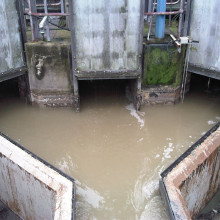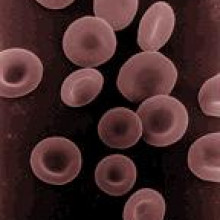In this week's NewsFlash, we find out how blood tests could predict an imminent heart attack, investigate what the Mercury Messenger probe has revealed about the planets environment one year on from its launch, discuss how sewers can provide insight into drug use within a population and discover how scientists are seeing around corners in 3D. Plus, a new drug target in the fight against male pattern baldness and how bears can heal wounds as they hibernate...
In this episode

00:17 - Messages from Mercury
Messages from Mercury
The MESSENGER spacecraft completed one Earth year of orbiting Mercury this month, and two papers published in the journal Science highlight some of the surprising scientific results from our solar system's innermost planet.
MESSENGER launched in 2004, and after a few successful flybys went into orbit around Mercury in March 2011. As well as taking images, it has been measuring the magnetic field, taking spectral analysis of the surface and atmosphere, and mapping the terrain, and has made some unexpected discoveries about the planet's surface and core.
 Using the results from laser altimetry to measure topography, it becomes obvious that Mercury's northern hemisphere has a lower dynamic range of elevations, or simply is less mountainous than Mars or the Moon. That's not to say Mercury has had an inactive life - there's plenty of evidence of meteorite bombardment and volcanism, and also that large scale changes have occurred since the last heavy bombardment, and even since the volcanic plains were laid down. Some impact craters have even tilted and distorted. This suggests that volcanic or tectonic activity must have been an as yet poorly understood part of Mercury's evolution.
Using the results from laser altimetry to measure topography, it becomes obvious that Mercury's northern hemisphere has a lower dynamic range of elevations, or simply is less mountainous than Mars or the Moon. That's not to say Mercury has had an inactive life - there's plenty of evidence of meteorite bombardment and volcanism, and also that large scale changes have occurred since the last heavy bombardment, and even since the volcanic plains were laid down. Some impact craters have even tilted and distorted. This suggests that volcanic or tectonic activity must have been an as yet poorly understood part of Mercury's evolution.
Some of the unusual surface features could be accounted for by Mercury's strange core. It takes up 85% of the planet's radius - much larger that we would predict from our understanding of Earth, where the core only accounts for 50%. It contains a vast amount of iron, which generates it's distinctive magnetic field. It also has an unusual structure; while Earth has a solid inner core surrounded by a liquid outer, it seems that Mercury has an extra layer of complication: A solid iron sulphide outer core, surrounding a liquid layer that in turn engulfs a solid inner core.
This core structure is unique among the planets we've been able to observe so far, but fits well with observations of Mercury's magnetic field, and helps to explain the strange chemistry of it's surface - we know that the crust contains far more sulphur than could otherwise be predicted. However, this structure would also restrict convection in the mantle, so is likely to stand in the way of a simple explanation for the surface features.
Mercury may still have some surprises for us - other reports hint at the existence of liquid water, for example - and due to it's success, MESSENGER's programme has been extended to probe even further.

03:51 - Drugs in sewage
Drugs in sewage
Drug use in populations, both legal and illegal, is important to know about for health and law and order reasons. Whilst it is relatively easy to keep tabs on the amount of legal drug use by asking pharmacies and other resellers, the purveyors of illegal drugs are unsurprisingly reticent with this sort of information. It is possible to study the users with questionaires, but they are not always accurate,
Drugs are not all destroyed by the body, and many are excreted, and so end up in the sewers, so one obvious place to look is there. The problem is that many illegal drugs are the same molecule as another legal counterpart, or can be created in the body from a legal molecule so it is hard to tell the difference.
Barbara Kasprzyk-Hordern and David Baker at the University of Huddersfield have used the fact that although both versions are often the same molecule parts of the molecules can be mirror images of one another, forming enantiomers. The ratio of these is often different in the legal and illegal versions.
They studied waste water from a variety of treatment works using liquid chromatography machines to seperate out different molecules, and their enantiomers and mass spectrometry to give a better idea what the molecule is.
They found various different drugs in the waste water including amphetamine, methamphetimine, MDMA or ecstasy, and ephidrine. By studying the percentage of the different enantiomers they could show how much of each was illegal useage.
The technique obviously needs a lot of calibration, as they do not yet know how the different molecules behave in sewage systems, but it could be an important tool in understanding just what is being used out there.

07:17 - Blood Tests to Predict Heart Attacks
Blood Tests to Predict Heart Attacks
Dr Eric Topol, Scripps Translational Science Institute, California
Researchers in the Scripps Translational Science Institute in California have developed a blood test that may be capable of predicting an imminent heart attack. Publishing in Science Translational Medicine, Eric Topol and colleagues built on early work that shows populations of unusual endothelial cells in blood samples taken from heart attack patients. These cells seem to come from the linings of arteries. So to find out why this was so interesting, Chris Smith spoke to Dr. Topol.....
Eric - Well, we have a very big unmet need and that is today, we can't diagnose heart attacks that are incubating. It's very easy to diagnose a heart attack where there's already been damage to the heart muscle. So there's enzymes in the blood and there's a cardiogram that shows that, but the limiting factor is that we can't tell when the artery has cracked before the blood clot has formed. It's the blood clot that causes the stoppage of blood flow to the heart muscle, so we want to know when that crack is occurring which is a precursor to a heart attack.
Chris - So how did you approach that problem?
Eric - We know that when someone has a heart attack, we have a narrowed area of a blood vessel which has an atheromatous deposit in it and for some reason, this atheromatous deposit ruptures, or cracks open, and this forms a blood clot which then blocks the vessel.
Chris - So with that in mind, how did you approach say, well is there a way to try and pre-empt when this might be about to happen and who's at risk?
Eric - Yes, so back in 1999, there was the first paper ever that showed that these cells that were presumably coming from the artery lining could be found in the bloodstream before a heart attack. And so, that was a very provocative paper that sat dormant for well over 12 years. We didn't really have until more recently the ability to unequivocally identify these cells as truly coming from the artery, and also to zoom in on them and to do such things as sequencing and elaborate studies to understand what these cells are all about.
 Chris - So what did you actually do? You have a group of patients who have a heart attack, you have another group of patients who are equivalent to the first group that haven't had a heart attack and you compare the cells in the blood of both?
Chris - So what did you actually do? You have a group of patients who have a heart attack, you have another group of patients who are equivalent to the first group that haven't had a heart attack and you compare the cells in the blood of both?
Eric - Right, so normally, there's very few of these cells, if any, are in a healthy person and the cells are very elliptical, with one nucleus, they're very consistent. Whereas in the heart attack individuals from their early minutes of their blood had nothing to do with the heart attack per se, these are cells that clearly have been present for some days prior to that. But what was so unique about these cells is they were giant, they were very distorted, and in clusters. And this is the first time that that's been demonstrated.
Chris - So let's piece this back together then. You get these blood samples from people who have had a heart attack and it looks like these cells were probably in circulation prior to the time they had the heart attack. There could therefore be a warning sign that something is about to happen. How do you think they got from the diseased artery into the test tube that you tested?
Eric - Well it's pretty straightforward. You know, there's a crack that's emerging in this inflamed segment of an artery from the surface of the heart and as the crack is growing, before the blood clot forms, these cells are just getting shed from a spot right into the blood and of course, once they're in the blood, just getting a blood tube sample is a window into that process.
Chris - It's reassuring that you found only a small number of these cells in  healthy people. But of course, I wonder whether you included in that control group, people who might have other risk factors but aren't having a heart attack because - is there going to be a gray area where you'll have people who have artery disease but they're not at imminent risk of a heart attack but your test looking for these cells might say they are?
healthy people. But of course, I wonder whether you included in that control group, people who might have other risk factors but aren't having a heart attack because - is there going to be a gray area where you'll have people who have artery disease but they're not at imminent risk of a heart attack but your test looking for these cells might say they are?
Eric - Well we haven't seen any gray area yet. You know, we've extended this in many different patients and we even took the healthy people and we kept having them come back which had never been done before to see how stable the finding is of their absence, or relative absence, of these cells. So, we tried to drill down on that quite a bit, Chris.
Chris - The big question must be, well how far in advance can we predict a forthcoming event and therefore intervene meaningfully in these people?
Eric - Well you know, this was a segue to a much more simple, quick and hopefully quite inexpensive test. The work that we did was too laborious, trying to isolate all these cells, but now that we've done genomics of these cells, and have a much easier signal to work with, we will take that to the emergency room setting to validate a practical test.
Chris - Wouldn't it be more meaningful to take a large group of individuals who are at risk and then just bring them back into the clinic on a weekly basis and get blood from them, and then marry up those blood samples with the ones who do then over time going to have a heart attack?
Eric - Yeah, that wouldn't work too well because you'd have to do that in thousands of people every week to get the few that are going to have a heart attack. It's not so easy to find people who are about to have a heart attack using that route. But if you go to the emergency room setting where people - for example in the US, there's 3 million people coming in with chest pain or tightness, or pressure, thinking that you might have a heart attack each year - and out of those, so many have no damage to their heart muscle but in fact are the exact kind of people that we're trying to identify because they are having this precursor event. So that's a much better way than just taking people who are perfectly stable with no symptoms, having to come back to a clinic every week. But, you're bringing up another point. This is a one off test. In order to have the blood under surveillance all the time, in high risk individuals like you were outlining, that will require a sensor embedded in the blood which we're working on as well that would communicate to one's Smartphone to give a ring tone that a heart attack is incubated.
Chris - I'm also getting at the point that we're coming up with all of these coronary risk profiles and we're saying to people, "You have a 10 % risk or you have a 15 % risk" and we're using this to inform what drugs we put people on. If we've got an even more acute measure, these are the individuals who are not just at risk but these are really elaborating a heart attack that's in evolution then they could actually be stratified for even more intense treatment and a heart attack could be prevented in those individuals.
Eric - You've nailed it. The point is, is that once you know the heart attack underlying process is ongoing, it's a heart attack waiting to happen, then the main thing is to prevent the blood clot. If we prevent the blood clot, then the chance of preventing the event is exceptionally high and naturally it becomes a new goal.
Ben - Eric Topol from the Scripps Translational Institute in La Jolla, California.

14:32 - Seeing Around the Corner
Seeing Around the Corner
Using a laser, a super fast camera and a clever algorithm, researchers at MIT have developed the ability to see, in 3D, around a corner.
Writing in the journal Nature Communications, Andreas Velten and colleagues at the Massachusetts Institute of Technology relied on the fact that scattered light will bounce off different surfaces, and that the time taken to bounce back to the camera can tell you the distances involved.
 Velten set up a test chamber by placing an object behind an opaque wall they called the occluder, and placing another wall, known as a diffuser, at right angles to and a small distance away from the occluding wall. They then fired extremely short busts of laser light at the diffusing wall, so the light would reflect off that wall, and scatter around the chamber. Some of that scattered light would fall upon the object; and bounce off again. Some of this doubly-reflected light would then hit the diffusing wall for a second time, and bounce back towards their camera.
Velten set up a test chamber by placing an object behind an opaque wall they called the occluder, and placing another wall, known as a diffuser, at right angles to and a small distance away from the occluding wall. They then fired extremely short busts of laser light at the diffusing wall, so the light would reflect off that wall, and scatter around the chamber. Some of that scattered light would fall upon the object; and bounce off again. Some of this doubly-reflected light would then hit the diffusing wall for a second time, and bounce back towards their camera.
Imaging this light with a normal camera would tell you very little, but the team used a special kind of camera called a streak camera. In a conventional camera, the position of a photon on the sensor represents it's position in the real world, so that they build up to create a realistic image. In a streak camera, photons are directed in such a way that the position on the sensor actually represents the time at which the sensor entered the camera, allowing you to record the arrival time of light to a resolution of 2 picoseconds.
This temporal resolution allows the distance that the light has travelled to be calculated, from which you can work out the relative distance between the diffusing wall and a hidden object. Moving the laser and repeating the process gives you a range of timing data that can be put through an algorithm to build up a 3D map of the area behind the occluding wall.
Being able to see around corners has obvious military applications, but would also be incredibly useful in dangerous environments, such as inside machinery or in contaminated or disaster areas. But it's not just man made structures that have corners; another application could be in endoscopy, looking inside the lungs or heart.

17:48 - Fighting Baldness and Healing Wounds through Hibernation
Fighting Baldness and Healing Wounds through Hibernation
George Cotsarelis, University of Pennsylvania; Jason Ur, Harvard University; Grant Lipman, Stanford University Medical School; David Garshelis, University of Minnesota
The Proteins Preventing Male Pattern Baldness
A new drug target to prevent male pattern baldness has been identified by scientists at the University of Pennsylvania.
scientists at the University of Pennsylvania.
By profiling the genes and resulting proteins in scalp tissue from males suffering from the condition, George Cotsarelis found that in samples of balding tissue, there were increased levels of the protein prostaglandin D2.
It's thought the protein inhibits hair growth in follicles by acting on a receptor known as GPR44 and targeting this receptor therapeutically could treat or
prevent male pattern baldness in the future.
George - If you look at the current treatments for male pattern baldness, they're all based on serendipitous findings but what we've done is we directly studied the disorder and looked for abnormalities in the actual scalp and we showed that this protein inhibits hair growth in both human hair follicles as well as mouse hair follicles. We then identified the receptor that this protein works through and there are compounds that target this receptor already. So we think that using these compounds would lead to a new treatment for male pattern baldness.
---
Spotting Archaeological Sites from Space
Satellite images have been used to identify over 9000 sites of early human settlement in North-Eastern Syria.
Researchers from Harvard University used computer algorithms to search the images for clues of human habitation such as soil discolouration caused by long-term human activity and elevated mounds of land created by populations building on top of previous remains.
Jason Ur led
the discovery...
Jason - This is significant because these places were not known before. We can now take this data set and we can ask really basic questions about the origins of settlement, the relationship of villages and cities to their environment. We can also take what we found and we can use this to protect these places in the face of new development threats which grow every year. What's particularly exciting about the method that we've developed is if I were to do this on the ground, it would take me a very long time. With this method, I can map out the possible places of settlement very quickly.
---
A Simpler drug for Altitude Sickness
 Ibuprofen can
Ibuprofen can
reduce your chances of suffering from altitude sickness, which can cause symptoms such as headaches and nausea and can be fatal.
Taking 86 volunteers up White mountain in California to altitudes of 12500 feet and dosing them with either ibuprofen or placebo , Grant Lipman from the Stanford University School of Medicine found that people taking the drug were 3 times less likely to show symptoms...
Grant - Up until now, the prevalent medications are prescription drugs like acetazolamide or dexamethasone, limited by prescription-only availability and each with side effects. So, we're really excited about the generalisability of these findings that can affect the tourists and the weekend warriors, and people who want to enjoy the mountains and don't want to be feeling awful for the first day or two days of their vacation.
---
Healing with Hibernation
Black bears can heal wounds during hibernation to emerge injury-free in the spring.
By inserting small cuts into the skin of 14 black bears before hibernation and monitoring the state of these wounds as they hibernate throughout the winter, David Garshelis from the University of Minnesota found that despite having a slower metabolism during this time, the bears replaced layers of skin at the injured sites and grew new hair with minimal scarring and no signs of infection.
David - Even though their skin temperature and their core temperature is greatly reduced and their blood circulation is greatly reduced, they are able to heal this wound and have very little scarring on the wounds and they even get follicle growth. All this is very different from other hibernators and obviously, very different from humans. We're hoping that if we can find out the mechanism that is used in bears to heal these wounds, maybe we can somehow apply it to help humans heal wounds, particularly when people don't have good circulation.
And that work is published this week in the
Journal of Integrative Zoology.
- Previous Is there an absolute maximum temperature?
- Next Going Nuclear










Comments
Add a comment